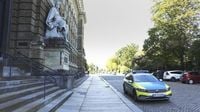In the early hours of Sunday, August 24, 2025, a late-night tram ride in Dresden, Germany, turned violent when a 20-year-old American man was attacked after intervening in the harassment of a female passenger. The incident, which left the victim with a deep wound to his face, has sparked outrage and prompted swift action from both German authorities and the U.S. Embassy in Berlin.
According to multiple reports from Associated Press, South China Morning Post, and Deutsche Welle, the attack occurred just after midnight while the tram was stopped. The American, whose name has not been released, stepped in when he saw two men harassing a woman on board. In an act of courage that would later be widely recognized, he attempted to protect the woman, only to become the target of a brutal assault himself. The attackers fled the scene, leaving the young man with a laceration to his face—a wound described by police as deep but not life-threatening.
The initial response from authorities was swift but complicated. On Sunday, a 21-year-old Syrian man was detained in connection with the incident. However, as prosecutors did not yet have sufficient grounds to keep him in custody, he was released soon after the initial questioning. This decision, while procedurally sound, left many—including those following the case closely—frustrated and anxious for justice.
But the story did not end there. By Tuesday morning, August 26, new information had come to light. Dresden police and prosecutors, after further investigation, determined there were now reasonable grounds to suspect the previously detained man of direct involvement in the attack. In a joint statement, authorities explained that the suspect was rearrested and placed in investigative custody on suspicion of grievous bodily harm and other offenses. According to the police press release, "after further investigation there was now reasonable grounds to suspect that he was involved in the knife attack against the 20-year-old American and also himself injured the victim with a dangerous object."
As of the latest updates, the 21-year-old Syrian remains in custody while investigations continue. The search for a second suspect, believed to have also participated in the assault, is ongoing. Authorities in Saxony have appealed to the public for any information that could help identify or locate the second man. Despite the arrest, the case remains open, and officials have cautioned that they are unable to provide further details at this time due to the ongoing nature of the investigation.
The reaction from the United States was both swift and unequivocal. On Monday, August 25, the U.S. Embassy in Berlin issued a statement on social media condemning what it called a "brutal attack." The embassy urged German authorities "to swiftly bring the perpetrators to justice and punish them to the fullest extent permitted by law." The strong language underscored the seriousness with which the U.S. government is treating the incident and its concern for the safety of American citizens abroad.
The embassy's call for justice echoed the sentiments of many who have followed the case. The fact that the victim was injured while attempting to defend someone else has resonated deeply, with several commentators and officials praising his bravery. Yet, as the investigation unfolds, there are lingering questions about the initial release of the suspect and the challenges authorities face in quickly gathering evidence in such cases.
German prosecutors and police have defended their actions, emphasizing that legal procedures must be followed to ensure that any charges brought will stand up in court. The initial lack of grounds for detention, they explained, was due to the absence of clear evidence directly implicating the suspect at that stage. However, as new information emerged, they acted promptly to rearrest the individual and move the case forward.
Beyond the immediate facts of the case, the incident has reignited broader discussions about public safety on public transportation systems in Germany and across Europe. Dresden, a city known for its rich history and vibrant cultural life, has not been immune to sporadic acts of violence in recent years. This attack, involving both a foreign victim and a suspect with refugee status, has added layers of complexity to the conversation, touching on issues of integration, law enforcement, and community cohesion.
For many residents and visitors, the attack is a stark reminder of the need for vigilance and effective policing, especially during late-night hours when fewer passengers and staff are present. Public transportation authorities in Dresden have reiterated their commitment to passenger safety, promising to review security measures and cooperate fully with the ongoing investigation.
The case has also highlighted the importance of bystander intervention—both its risks and its necessity. The American victim's decision to step in on behalf of a harassed woman is being lauded as an act of moral courage, even as it resulted in serious personal harm. "He intervened when two men harassed a woman on board and was then attacked himself before the men fled," police confirmed. Such actions, while commendable, underscore the dangers faced by those who choose to stand up against wrongdoing in public spaces.
Meanwhile, the search for the second suspect continues. As of August 27, authorities had not yet located the individual, and appeals for witnesses remain active. The lack of immediate resolution has left some in the community uneasy, though police stress that every available resource is being deployed to bring both perpetrators to justice.
The victim, who was hospitalized following the attack, is expected to recover from his injuries. Police have described the wounds as "not life-threatening," but the psychological impact of such a violent encounter can linger long after physical scars have healed. Support services have been offered to the victim, and both local officials and embassy representatives have expressed their wishes for his speedy recovery.
As investigations proceed, the case serves as a sobering reminder of the unpredictable dangers that can arise in everyday settings—and the importance of both personal bravery and institutional accountability in responding to them. The eyes of both Germany and the United States remain fixed on Dresden, awaiting justice for a young man who, in a moment of crisis, chose to do the right thing, no matter the cost.



